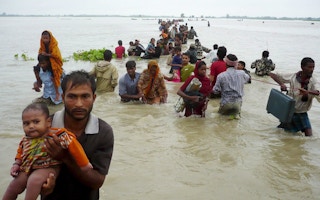Living in Sydney by the end of the century will be like living in Rockhampton, subtropical Queensland, if global temperatures are allowed to rise by four degrees - the current trajectory of climate change.
Melbourne’s climate will be akin to Griffith in regional NSW and Canberra will feel like outback Cobar.
Alice Springs will mirror modern-day Sudan, while Darwin will be like no other city on earth in 2013. The Top End would be virtually uninhabitable, with more than 300 days a year of 35-plus degree heat.
The downside to warmer winters on the eastern seaboard in 2100 is the prospect of “anarchy” in our region prompted by the dislocation of 250 million people from the Asia-Pacific, climate refugees who will need to be resettled in part in Australia.
The “profound” shift in living conditions as a result of climate change is raised in Four Degrees of Global Warming: Australia in a hot world, a compilation of climate science literature to be launched in Melbourne on Wednesday.
The book explores the dire changes that are likely to accompany four degrees of warming on 1990 levels, including Australia becoming reliant on food imports as a result of a 90 per cent decline in agricultural production in the Murray-Darling food bowl.
Other consequences include:
- 250,000 coastal properties inundated by rising sea levels at a total cost of $63 billion
- 17,200 heat-related deaths a year - up from 5800 today
- Snow will disappear from all but the highest alpine peaks
- 250 million people in the Asia-Pacific will be displaced.
The mass exodus from low-lying Bangladesh and coastal cities of China, Indonesia and India poses perhaps the biggest challenge for Australia, which could face a wave of climate refugees on a scale that would dwarf the current asylum seeker crisis.
In a chapter written by Professor Ross Garnaut, the prospect of “anarchy” and the breakdown of nation states is raised.
“Warming of 4 degrees celsius and more would precipitate such large change in global politics as to force the reshaping of national boundaries,” Garnaut writes. “It may lead to a small number of more effective states combating anarchy by absorbing others.
“The survival of states with anything like the current boundaries and roles would be one of the less likely eventualities.”
Professor Garnaut believes there is “still a chance that global mitigation efforts will hold global warming to two degrees” as long as countries are willing to turn up to the Paris climate change conference in 2015, prepared to commit to deep emissions cuts post-2020.
The book’s main author, Peter Christoff, an Associate Professor at Melbourne University said Australia would need to swap its five per cent emissions reduction target to 38 per cent within 10 years to keep warming under two degrees.
“It’s inappropriate for us to wait for a global agreement. Delaying is going to be more costly and less efficient. There’s no point in delay,” he told Fairfax Media.
“We have about a decade.”








